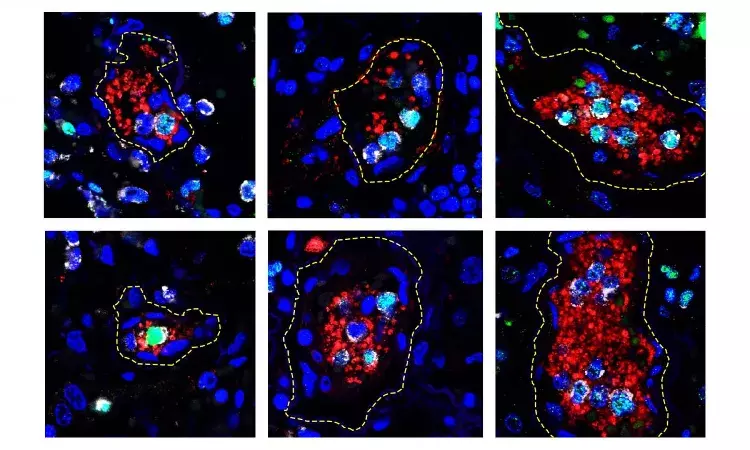- Home
- Medical news & Guidelines
- Anesthesiology
- Cardiology and CTVS
- Critical Care
- Dentistry
- Dermatology
- Diabetes and Endocrinology
- ENT
- Gastroenterology
- Medicine
- Nephrology
- Neurology
- Obstretics-Gynaecology
- Oncology
- Ophthalmology
- Orthopaedics
- Pediatrics-Neonatology
- Psychiatry
- Pulmonology
- Radiology
- Surgery
- Urology
- Laboratory Medicine
- Diet
- Nursing
- Paramedical
- Physiotherapy
- Health news
- Fact Check
- Bone Health Fact Check
- Brain Health Fact Check
- Cancer Related Fact Check
- Child Care Fact Check
- Dental and oral health fact check
- Diabetes and metabolic health fact check
- Diet and Nutrition Fact Check
- Eye and ENT Care Fact Check
- Fitness fact check
- Gut health fact check
- Heart health fact check
- Kidney health fact check
- Medical education fact check
- Men's health fact check
- Respiratory fact check
- Skin and hair care fact check
- Vaccine and Immunization fact check
- Women's health fact check
- AYUSH
- State News
- Andaman and Nicobar Islands
- Andhra Pradesh
- Arunachal Pradesh
- Assam
- Bihar
- Chandigarh
- Chattisgarh
- Dadra and Nagar Haveli
- Daman and Diu
- Delhi
- Goa
- Gujarat
- Haryana
- Himachal Pradesh
- Jammu & Kashmir
- Jharkhand
- Karnataka
- Kerala
- Ladakh
- Lakshadweep
- Madhya Pradesh
- Maharashtra
- Manipur
- Meghalaya
- Mizoram
- Nagaland
- Odisha
- Puducherry
- Punjab
- Rajasthan
- Sikkim
- Tamil Nadu
- Telangana
- Tripura
- Uttar Pradesh
- Uttrakhand
- West Bengal
- Medical Education
- Industry
New evidence for how blood clots may form in very ill COVID-19 patients
 IMAGE: PHOTOMICROGRAPHS OF HUMAN LUNG TISSUE TAKEN FROM A PATIENT WHO DIED OF COVID-19. THESE ARE EXAMPLES OF THE NEUTROPHIL EXTRACELLULAR TRAP (NET) STRUCTURES ASSOCIATED WITH SMALL BLOOD CLOTS. SMALL BLOOD... view more CREDIT: XUE-YAN HE AND DAVID NG, EGEBLAD LAB/CSHL, 2020
IMAGE: PHOTOMICROGRAPHS OF HUMAN LUNG TISSUE TAKEN FROM A PATIENT WHO DIED OF COVID-19. THESE ARE EXAMPLES OF THE NEUTROPHIL EXTRACELLULAR TRAP (NET) STRUCTURES ASSOCIATED WITH SMALL BLOOD CLOTS. SMALL BLOOD... view more CREDIT: XUE-YAN HE AND DAVID NG, EGEBLAD LAB/CSHL, 2020Scientists have new evidence that overactive neutrophils--a common type of circulating immune cell--may drive the life-threatening blood clots and inflammation that occur in some patients with COVID-19. High levels of the sticky, pathogen-trapping webs produced by the cells were associated with the most severe cases of COVID-19 in a study reported online in the journal Blood.
Neutrophil extracellular traps (NETs) are a type of defense that the immune system deploys against certain pathogens--webs of DNA and toxins that ensnare and destroy viruses and bacteria. When too many of these NETs accumulate during a persistent infection, they can lead to acute respiratory distress syndrome, which leads many patients with COVID-19 to require intensive care.
Researchers at Cold Spring Harbor Laboratory (CSHL), University of Utah Health, PEEL Therapeutics and Weill Cornell Medicine collaborated to investigate NETs suspected role in COVID-19, collecting blood samples from 33 hospitalized patients, as well as autopsy tissue. They found that biomarkers of NET formation were more abundant in patients who required ventilation, and highest in the three study participants who eventually died from COVID-19.
When the team examined the lungs of the patients who died, they found tiny clots of tangled NETs and blood platelets known as microthrombi scattered through the tissue. "It will be important to investigate NETs role in clot formation (thrombosis) not only in light of the COVID-19 pandemic, but also to understand their broader role in disease," says CSHL Associate Professor Mikala Egeblad.
"Excess NETs are formed in other viral diseases," she says. "We also know that clotting is a major cause of death in people with end-stage cancer, so what we are learning in COVID-19 may help us understand basic properties in cancer and other diseases."
In the laboratory, neutrophils from patients with COVID-19 churned out exceptionally high levels of NETs, and the researchers found healthy neutrophils behaved the same way when they were exposed to plasma from patients with the illness. They could stop NET production, however, by exposing cells to neonatal NET-Inhibitory Factor (nNIF), an anti-inflammatory peptide from umbilical cord blood that protects newborn babies.
Several therapeutic strategies for dismantling NETs or preventing their formation are currently under investigation. These include the nNIF peptide, which is in pre-clinical development by PEEL Therapeutics. "Although further studies will be required, the NET-inhibitory protein may block exaggerated NET formation in COVID-19 patients," says Christian Con Yost, whose laboratory at University of Utah Health discovered nNIF in 2016.
Hina Zahid Joined Medical Dialogue in 2017 with a passion to work as a Reporter. She coordinates with various national and international journals and association and covers all the stories related to Medical guidelines, Medical Journals, rare medical surgeries as well as all the updates in the medical field. Email: editorial@medicaldialogues.in. Contact no. 011-43720751
Dr Kamal Kant Kohli-MBBS, DTCD- a chest specialist with more than 30 years of practice and a flair for writing clinical articles, Dr Kamal Kant Kohli joined Medical Dialogues as a Chief Editor of Medical News. Besides writing articles, as an editor, he proofreads and verifies all the medical content published on Medical Dialogues including those coming from journals, studies,medical conferences,guidelines etc. Email: drkohli@medicaldialogues.in. Contact no. 011-43720751


